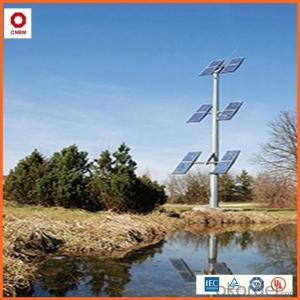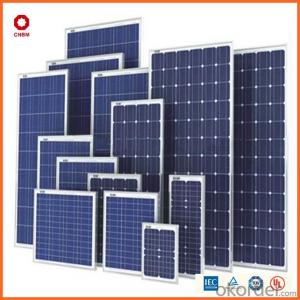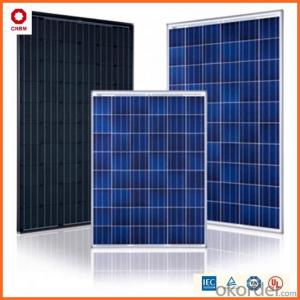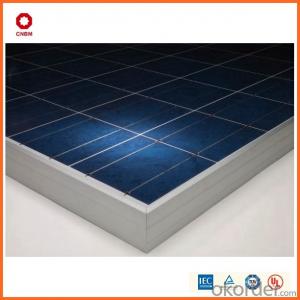!!! Hot On Sale!!! Stock Small Solar Panel 50w Poly with Good Quality
- Loading Port:
- China main port
- Payment Terms:
- TT OR LC
- Min Order Qty:
- 1 watt
- Supply Capability:
- 10000000 watt/month
OKorder Service Pledge
OKorder Financial Service
You Might Also Like
Product Description:
Hot Sale !!! Quality and Safety of Small Poly Solar Panel 35~85w
1. Rigorous quality control meets the highest international standards.
2. High-transmissivity low-iron tempered glass, strong aluminium frame.
3. Using UV-resistant silicon.
4. IS09001/14001/CE/TUV/UL
Warranties of Small Poly Solar Panel 35~85w
1. 10 years limited product warranty
2. 15 years at 90% of the minimal rated power output
3. 25 years at 80% of the minimal rated power output
Technical date of 45w-85w Poly Solar Panel
ITEM NO.: | Mono 125*125 cell ,36pcs . Power range from 80Wp-100Wp | ||||||||
Maximum Power(W) | 80 | 85 | 90 | 95 | 100 | ||||
Optimum Power Voltage(Vmp) | 17.81 | 17.89 | 17.94 | 17.99 | 18.06 | ||||
Optimum Operatige Current(Imp) | 4.78 | 4.91 | 5.12 | 5.35 | 5.59 | ||||
Open Circuit Voltage(Voc) | 21.98 | 22.05 | 22.14 | 22.28 | 22.45 | ||||
Short Circuit Current(Isc) | 4.95 | 5.15 | 5.36 | 5.65 | 5.84 | ||||
Solar Cell: | 125*125 Mono | ||||||||
Number of Cell(pcs) | 4*9 | ||||||||
Brand Name of Solar Cells | JA Cell, Bluesun Cell | ||||||||
Size of Module(mm) | 1580*808*35 | ||||||||
Caple & Connector Type | Pass the TUV Certificate | ||||||||
Frame(Material Corners,etc.) | Aluminium-alloy | ||||||||
Backing (Brand Type) | TPT | ||||||||
Cell Efficiency for 100W(%) | 15.8% | ||||||||
Weight Per Piece(KG) | 12.0KG | ||||||||
FF (%) | 70-76% | ||||||||
Junction Box Type | Pass the TUV Certificate | ||||||||
Tolerance Wattage(e.g.+/-5%) | ±3%, or 0-3% | ||||||||
Front Glass Thikness(mm) | 3.2 | ||||||||
Temperature Coefficients of Isc(%) | +0.04 | ||||||||
Temperature Coefficients of Voc(%) | -0.38 | ||||||||
Temperature Coefficients of Pm(%) | -0.47 | ||||||||
Temperature Coefficients of Im(%) | +0.04 | ||||||||
Temperature Coefficients of Vm(%) | -0.38 | ||||||||
Temperature Range | -40°C to +85°C | ||||||||
Surface Maximum Load Capacity | 2400Pa | ||||||||
Allowable Hail Load | 23m/s ,7.53g | ||||||||
Bypass Diode Rating(A) | 12 | ||||||||
Warranty | 90% of 10 years,80% of 25 years. | ||||||||
Standard Test Conditions | AM1.5 1000W/ 25 +/-2°C | ||||||||
Packing | carton or pallet | ||||||||
1*20' | 25 Pallets / 450pcs | ||||||||
1*40'STD | 25 Pallets / 100pcs | ||||||||
Features of our products:
• High conversion efficiency mono/poly-crystalline amorphous silicon solar cells
• Modules incorporate high performance bypass diodes to minimize the power drop caused by shading
• High transmittance, low-iron tempered glass
• High performance EVA encapsulant to prevent destroying and water.
• AI frame: without screw, corner connection. 8 holes on the frame can be installed easily
• Good performance of preventing from atrocious weather such as wind and hails
• Certifications: CE IEC TUV VDE UL, Class I
• 10 years 90% power output warranty

Shipping of Small Poly Solar Panel 35~85w
By Sea | Delivery from Shanghai or Ningbo seaport |
By Air | Departure from Shanghai Pudong Airport |
By Express | Post by DHL, EMS, UPS, TNT. |
- Q:What is the role of solar energy systems in reducing water usage?
- Solar energy systems play a significant role in reducing water usage by providing a sustainable and renewable source of power that reduces reliance on water-intensive energy sources like fossil fuels and nuclear power. Solar power does not require water for operation, unlike coal or gas-fired power plants that consume large amounts of water for cooling. By promoting the adoption of solar energy systems, we can effectively conserve water resources and contribute to a more sustainable future.
- Q:Can solar energy systems be used in powering car charging stations?
- Yes, solar energy systems can definitely be used to power car charging stations. In fact, many car charging stations around the world are already powered by solar energy. Solar panels can be installed on the roof or nearby the charging station, which then captures sunlight and converts it into electricity. This renewable energy can be used to charge electric vehicles (EVs) without relying on the traditional power grid. Solar-powered car charging stations offer several advantages. Firstly, they provide a sustainable and clean source of energy, reducing carbon emissions and the overall environmental impact of EVs. Secondly, they can be installed in remote or off-grid locations where it may be challenging or expensive to connect to the electrical grid. This makes solar-powered charging stations particularly beneficial for rural areas or highways that lack easy access to electricity. Furthermore, solar energy systems can be designed to include battery storage, allowing the excess energy generated during the day to be stored and used during the night or during times of high demand. This ensures a continuous and reliable source of power for car charging stations, even when sunlight is not available. Although the initial installation cost of solar energy systems may be higher compared to traditional power sources, they generally have lower operating and maintenance costs in the long run. Additionally, there are various government incentives and rebates available to promote the use of renewable energy, which can help offset these initial costs. Overall, solar energy systems are a viable and sustainable solution for powering car charging stations, offering environmental benefits, energy independence, and cost savings in the long term.
- Q:Can solar energy systems be used in areas with high levels of bird activity?
- Solar energy systems can indeed be used in areas where there are many birds. However, it is crucial to take precautions in order to ensure the safety of the birds and the optimal performance of the solar panels. A common concern is the possibility of birds colliding with the panels. To address this, manufacturers often include bird deterrents such as mesh screens or reflective coatings on the panels, which make them more visible to birds and decrease the risk of collisions. Additionally, proper installation and maintenance of the solar energy systems can minimize potential nesting or roosting sites for birds, thus reducing the likelihood of damage to the panels. By addressing these considerations, it is possible to effectively utilize solar energy systems in areas with high bird activity while still protecting the local bird population.
- Q:How long does it take to install a solar energy system?
- The time it takes to install a solar energy system can vary depending on factors such as the size of the system, complexity of the installation, and the availability of equipment and manpower. However, on average, a typical residential solar panel installation can take anywhere from one to three days.
- Q:Can solar energy systems be used in all regions?
- No, solar energy systems can be used in all regions, but their efficiency and effectiveness may vary depending on factors such as sunlight availability, weather conditions, and geographical location.
- Q:What are the environmental impacts of solar energy systems?
- Solar energy systems have several positive environmental impacts. Firstly, they produce clean and renewable energy, reducing the reliance on fossil fuels and decreasing greenhouse gas emissions. Additionally, solar panels do not emit any pollutants during operation, contributing to improved air quality. However, the manufacturing process of solar panels can have some environmental impacts, including the use of certain materials and energy-intensive production. Nevertheless, when considering the entire lifecycle of solar energy systems, the environmental benefits far outweigh the potential drawbacks.
- Q:What is net metering?
- Net metering is a billing arrangement that allows solar panel owners to receive credit for the excess electricity they generate and feed back into the grid. This means that when their solar panels produce more electricity than they need, the surplus is sent to the grid, effectively spinning their energy meter backwards and reducing their future electricity bills.
- Q:Can solar energy systems be used to heat water?
- Yes, solar energy systems can be used to heat water through the use of solar thermal collectors or solar water heaters. These systems absorb sunlight and convert it into heat, which is then used to warm the water for various purposes such as domestic use, swimming pools, or even industrial processes.
- Q:Can solar energy systems be used for powering off-grid communities?
- Yes, solar energy systems can definitely be used for powering off-grid communities. They provide a reliable and sustainable source of electricity in remote areas where grid connection is not feasible or economically viable. Solar panels capture sunlight and convert it into electricity, which can be stored in batteries for use during nighttime or cloudy days. This makes solar energy an ideal solution for off-grid communities, as it reduces their dependence on fossil fuels and helps in achieving energy independence.
- Q:Can solar energy systems be used in areas with limited access to solar energy support networks?
- Yes, solar energy systems can still be used in areas with limited access to solar energy support networks. Off-grid solar systems, also known as standalone solar systems, can be installed in such areas where there is no access to a centralized power grid or solar energy support network. These systems are designed to generate and store electricity locally, using solar panels and batteries. While they may require initial investment and maintenance, they provide a sustainable and reliable source of energy, even in remote or underdeveloped regions.
1. Manufacturer Overview |
|
|---|---|
| Location | |
| Year Established | |
| Annual Output Value | |
| Main Markets | |
| Company Certifications | |
2. Manufacturer Certificates |
|
|---|---|
| a) Certification Name | |
| Range | |
| Reference | |
| Validity Period | |
3. Manufacturer Capability |
|
|---|---|
| a)Trade Capacity | |
| Nearest Port | |
| Export Percentage | |
| No.of Employees in Trade Department | |
| Language Spoken: | |
| b)Factory Information | |
| Factory Size: | |
| No. of Production Lines | |
| Contract Manufacturing | |
| Product Price Range | |
Send your message to us
!!! Hot On Sale!!! Stock Small Solar Panel 50w Poly with Good Quality
- Loading Port:
- China main port
- Payment Terms:
- TT OR LC
- Min Order Qty:
- 1 watt
- Supply Capability:
- 10000000 watt/month
OKorder Service Pledge
OKorder Financial Service
Similar products
New products
Hot products
Related keywords






























